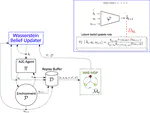Biography
I am a PhD student in the AI lab of the Vrije Universiteit Brussel (VUB), under the supervision of Ann Nowé (AI Lab, VUB) and Guillermo A. Pérez (University of Antwerp). My research interests lie in the fields of artificial intelligence and formal verification. More specifically, my PhD focuses on the formal verification of single- and multi-agent policies obtained through reinforcement learning. The end goal of my research is to provide end-users with reliable AI mechanisms.
News Feed Follow @twitter
- Our paper The Wasserstein Believer: Learning Belief Updates for Partially Observable Environments through Reliable Latent Space Models has been accepted to ICLR 2024!
- Check out our new preprint: Synthesis of Hierarchical Controllers Based on Deep Reinforcement Learning Policies.
Interests
- Reinforcement learning
- Model checking and synthesis
- Multi-objective decision making
- Planning under uncertainty and partial observability
- Deep generative modeling
- Multi-agent systems
Education
PhD in Computer Science
Vrije Universiteit Brussel (VUB), Belgium
Master in Computer Science, 2018
University of Mons (UMONS), Belgium
Bachelor in Computer Science, 2016
UMONS, Belgium
Experience
Doctoral researcher
Formal verification of single- and multi-agent policies obtained through reinforcement learning.
Scientific Researcher
RWTH Aachen University and UMONS
Many-sided synthesis in stochastic systems.
Data science intern
Trained machine learning models to detect, identify, and troubleshoot several impairments impacting DSL lines.
Research intern
Introduction to research internship, in the software engineering lab. Development of a software tool for generating state machine visualizations from UML statechart specifications.
Publications
(2024).
Synthesis of Hierarchical Controllers Based on Deep Reinforcement Learning Policies.
arXiv Preprint.
(2023).
The Wasserstein Believer: Learning Belief Updates for Partially Observable Environments through Reliable Latent Space Models.
The Twelfth International Conference on Learning Representations, ICLR 2024.
(2023).
WAE-PCN: Wasserstein-autoencoded Pareto Conditioned Networks.
Proceedings of the Adaptive and Learning Agents Workshop (ALA 2023).
(2023).
Wasserstein Auto-encoded MDPs: Formal Verification of Efficiently Distilled RL Policies with Many-sided Guarantees.
The Eleventh International Conference on Learning Representations, ICLR 2023.
(2022).
Distillation of RL Policies with Formal Guarantees via Variational Abstraction of Markov Decision Processes.
Proceedings of the AAAI Conference on Artificial Intelligence Vol. 36 No. 6: AAAI-22 Technical Tracks 6, 6497-6505.
Cite Code Project DOI URL Extended Abstract Technical Report
(2022).
A Framework for Flexibly Guiding Learning Agents.
Neural Computing and Applications, Special Issue on Adaptive and Learning Agents 2021.
(2020).
Life is Random, Time is Not: Markov Decision Processes with Window Objectives.
Logical Methods in Computer Science, December 14, 2020, Volume 16, Issue 4.
(2020).
Simple Strategies in Multi-Objective MDPs.
Tools and Algorithms for the Construction and Analysis of Systems - 26th International Conference, TACAS 2020, Held as Part of the European Joint Conferences on Theory and Practice of Software, ETAPS 2020, Dublin, Ireland, April 25-30, 2020, Proceedings, Part I.
(2019).
Life Is Random, Time Is Not: Markov Decision Processes with Window Objectives.
30th International Conference on Concurrency Theory, CONCUR 2019, August 27-30, 2019, Amsterdam, the Netherlands.
Projects
Honors & Awards
Contact
- Pleinlaan 9, Artificial Intelligence Lab, Vrije Universiteit Brussel, Brussels, B-1050
- Building 9, 3rd floor




